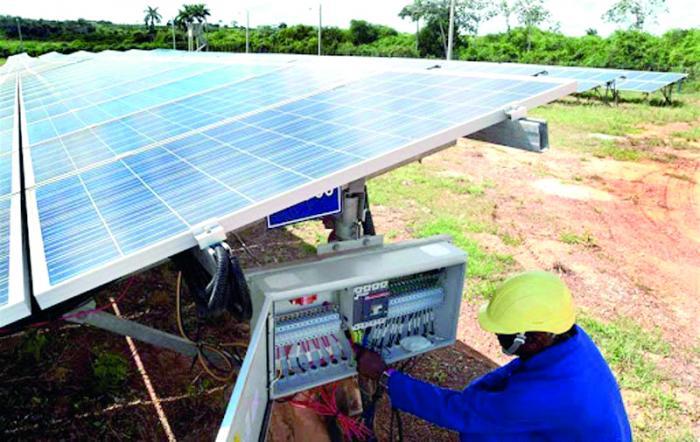Cuba advances with major renewable energy project
September 28, 2024

The struggle to build renewable energy generation is central to Cuba defending itself from the illegal US blockade which has been inflicted on the island for 61 years, the longest regime of economic sanctions in history. On 12 September, Cuba’s foreign minister Bruno Rodriguez presented a report which he will submit to the UN General Assembly ahead of an annual vote on 30 October on a motion to condemn the US blockade of Cuba, the 32nd such vote. As Rodriguez explained, the blockade costs Cuba $339m every 25 days – enough to purchase all the basic medications required by the country in a whole year.
A particular area of urgent need for Cuba is in energy production, with Cuba still overly dependent on imported oil and ageing infrastructure. After former US President Donald Trump imposed targeted sanctions against oil tankers docking in Cuba, shortages of fuel worsened. Since 2020 scheduled blackouts have become a familiar privation for many Cubans; they are implemented across the island to ration electricity, sometimes lasting up to 12 hours per day.
After years of delays, Cuba now has a credible plan to achieve its goal of installing 700 megawatts (MW) of solar energy farms and 24% renewable electricity generation by 2030. This will mark a leap forward in resolving Cuba’s ongoing energy crisis and in its long-term state plan to confront climate change.
Cuba finished 2023 with a capacity of 286 MW across its solar farms, with renewables (including solar, wind and hydroelectric power) making up 4% of electricity generation. So far in 2024 a further 12MW has been added as a donation by the Chinese government. Now, in a programme announced in July 2024, 92 more facilities will be built with financing from China, which will total 2,012MW. When completed, these will provide 3,400 gigawatt hours per year, saving 890,000 tons of fossil fuel. By the end of 2024 supplies are due to arrive from China for construction facilities to produce 135 MW in 2025. The US blockade has been cited as the major obstacle in obtaining these supplies.
China began helping Cuba install solar energy farms in 2016, when The Bank of China and Ministry of Commerce of China financed solar facilities in Pinar del Rio and Yaguaramas. These were completed in 2018 and are operated by the Ministry of Energy and Mines, producing 9 MW per year from 35,000 solar panels. In 2017, the Cuban state and China agreed a joint venture to build a biomass electricity plant in Ciro Redondo, financed by the private Chinese company Shanghai Electric, completed in early 2020. Shanghai Electric also provided funding, in a joint venture with British firm Hive Energy, for the Mariel Special Development Zone solar farm project, consisting of three solar energy facilities with 300,000 solar panels producing 62 MW. The project was originally a joint venture between British company Hive Energy and France’s EREN Renewable Energy in 2015 but faced severe delays due to a shortage of capital when the French financiers pulled out in 2017. It was only with Chinese investment that the facilities could be constructed and became operational in 2021, two years behind schedule. In October 2021, Cuba formally joined China’s Belt and Road Initiative Energy Partnership, through which China provides financing for renewable energy infrastructure in agreements with more than 30 countries.
This is an uphill battle – the case of the delayed Mariel solar project is echoed throughout the country as it struggles to obtain the necessary capital for development amidst the stifling fear of US sanctions. In 2016, Cuba made agreements with Spanish company Gamesa and German company Siemens for energy infrastructure development. Both projects could never begin due to lack of financing. The US Office of Foreign Assets Control (OFAC), which enforces the illegal blockade on companies based third countries, has fined European institutions like BNP Paribas and the Royal Bank of Scotland for providing services related to Cuba, and in 2024 OFAC fined the Swiss bank EFG the sum of $3.7m for sanctions violations including in relation to Cuba.
While many of the country’s renewable energy projects necessarily rely on loans, technology and in some cases investment from foreign companies – and therefore private ownership – Cuba’s socialist revolution directs national production according to a central plan based on meeting the needs of the population rather than anarchic capitalist competition. Solar energy projects have prioritised electrifying rural communities, and all renewables projects are implemented alongside improving efficiency and decreasing electricity consumption. The central state plan is overall managed by local community organising (see People first: Cuba’s plan to confront climate change, FRFI 294). This is in stark contrast to the capitalist states which make empty ‘green’ promises whilst destroying the natural world in the pursuit of profit (see Climate Crisis and the Working Class, FRFI 300). In Britain, despite being a wealthy capitalist country which is not under the burden of a blockade, a winter fuel crisis looms over the poorest sections of the working class forced to choose between heating or eating. The Labour government has no credible plan to mitigate the climate crisis or any intention of placing restrictions on the ecocide caused by British imperialism.
The concrete agreements to build new solar energy plants represent significant progress towards Cuba’s sustainability goals. However, the resolution of Cuba’s national energy crisis will take years and its success still depends on international solidarity to fight the blockade.
Search
RECENT PRESS RELEASES
Related Post


